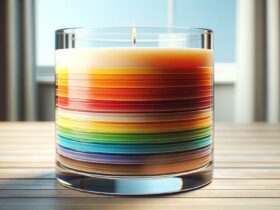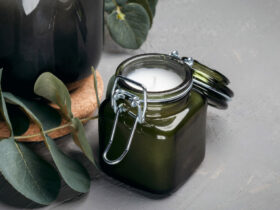Candle making is not just a craft; it’s an expression of creativity and personal taste. Delving into the world of making container candles offers a satisfying blend of artistry and simplicity. This guide provides a step-by-step approach to creating your own beautiful container candles. From selecting the right materials to the final touches, you’ll learn how to bring warmth and personality to your space through this DIY project.
Make Container Candles: Key Takeaways
- The type of wax used in container candles affects the texture and fragrance absorption, with options like CBL-125 for smooth textures and CBL-129 for high scent retention.
- Choosing the right wick, such as Zinc Core wicks, is crucial for container candles, and it should be matched with the wax type and container diameter.
- Container choice impacts the candle’s aesthetic and functionality, with wide-necked glass, ceramic, or metal containers being popular for better airflow and heat resistance.
- Setting up a safe and organized workspace is essential in candle making, involving tools like a pouring pot, thermometer, glue dots, and a stir stick.
- The candle making process includes melting wax, adding color and fragrance, preparing the container and wick, pouring wax, and allowing it to cool and set properly.
Essential Materials for Container Candle Making
Making container candles is a delightful and creative activity that requires specific materials to ensure a successful and enjoyable experience. Here’s a comprehensive list of materials you will need to make candles:
- Wax: The foundation of your candle. Popular choices include soy wax, paraffin wax, beeswax, and specialized waxes like CBL-125 for a smooth finish or CBL-129 for enhanced fragrance absorption.
- Wicks: Essential for the candle to burn. Zinc Core wicks are recommended for container candles. Ensure the wick size is appropriate for your wax type and container size.
- Containers: The vessel for your candle. Choose from glass, ceramic, or metal containers, preferably with wide necks for better air circulation. Ensure the container is heat-resistant.
- Fragrance Oils: To add scent to your candles. You can also use essential oils, but make sure they are compatible with candle making.
- Color Dyes: If you wish to add color to your candles. Dye blocks or liquid candle dyes are available.
- Double Boiler: For melting the wax. If you don’t have a double boiler, you can use a makeshift one with a pot and a heat-proof bowl.
- Thermometer: To accurately measure the temperature of the melting wax, ensuring it’s suitable for adding fragrance and dyes.
- Pouring Pot: To transfer melted wax into the container.
- Stir Stick: To mix the wax, fragrance, and color evenly.
- Glue Dots or Wick Stickers: To secure the wick at the bottom of the container.
- Wick Centering Tool or Chopsticks: To keep the wick centered while the wax is cooling.
- Protective Coverings: Like butcher paper or newspaper, to cover your workspace and make cleanup easier.
- Safety Gear: Gloves and apron to protect yourself from hot wax.
- Scissors or Wick Trimmer: To trim the wick to the appropriate length before and after burning.
Remember, the choice of materials can vary based on personal preference, the type of candle you wish to make, and the level of experience in candle making. Each material plays a crucial role in the candle making process, influencing the candle’s burn quality, appearance, and fragrance throw.
What Are the Best Materials to Make Your Candle?
When it comes to making container candles, the choice of materials significantly impacts the final product. The type of wax you choose is crucial. CBL-125 is known for its smooth texture and minimal wet spots, making it ideal for smaller containers. For those who love a strong fragrance, CBL-129 is perfect as it’s designed for high levels of scent absorption. If you’re aiming for a rustic, mottled look, the 126 Melt Point Wax 2530 H is your go-to choice.
Selecting the right wick is equally important. Zinc Core wicks are often recommended for container candles due to their ease of use and ability to maintain a central position. The wick size should match the diameter of your container and the type of wax used.
The container itself is not just a vessel but a part of the candle’s aesthetic. Choose containers with wide necks for better air flow, and consider the material – glass, ceramic, and metal are popular choices.
Wax Varieties and Their Properties
In candle making, the type of wax is crucial, especially for container candles. The three main types are soy wax, paraffin wax, and beeswax, each with distinct properties.
In container candle making, soy wax stands out for its eco-friendly qualities. It’s particularly suited to container candles due to its excellent adherence to the sides, ensuring a clean and even burn. This reduces the common issue of tunneling, where wax accumulates on the container’s sides. Soy wax’s slower burning rate also prolongs the candle’s life, making it a cost-effective and environmentally conscious choice.
Conversely, paraffin wax is renowned for its strong scent throw and vibrant color retention, ideal for creating aromatic and visually appealing container candles. However, it tends to produce more soot than soy wax. Beeswax, with its natural, subtle scent, offers a clean and bright burn but is less commonly used due to higher costs and lower fragrance retention.
Each wax type caters to specific aspects of container candle functionality, from eco-friendliness to aesthetic appeal.
Choosing the Right Wick
The wick is the heart of your candle. Its size and material directly affect how your candle burns and releases fragrance. For a 2″-3″ diameter candle using CBL-125, a 44-24-18 zinc wick is a good starting point. If you’re using CBL-129 or 2530 H, you may need to adjust the wick size. Remember, the denser the wax and the more additives (like fragrance and color), the larger the wick you may need.
Choosing the Right Container for Your Candles
Containers not only hold your candle but also contribute to its character. Standard apothecary jars are a popular choice, available in various sizes like 15 oz., 22 oz., and 32 oz, however, there are plenty of other options like metal or ceramic jars. When choosing containers for candle making, consider the wax’s melting point and the container’s heat resistance. Always test your container with a small amount of wax to ensure it can withstand the heat without cracking.
The Step-by-Step Candle Making Process
Safety and organization are key in candle making. Cover your workspace with butcher paper or newspaper for easy cleanup. Essential tools include a pouring pot, thermometer, glue dots for securing wicks, and a stir stick.
- Melting Wax and Adding Extras: Heat your wax in a double boiler to the recommended temperature range (170° – 180°). Add color and fragrance as desired. For a consistent color, use dye blocks and add them gradually. For fragrance, 1 ounce per pound of wax is a standard measure.
- Preparing the Container and Wick: Secure the wick to the bottom of the container using glue dots or wick stickers. Ensure the wick is centered to promote even burning.
- Pouring the Wax and Cooling: Pour the wax slowly to avoid air bubbles. Allow the candle to cool at room temperature. Avoid moving the candle during this stage as it can cause the wax to slosh and form an uneven surface.
Troubleshooting Common Candle Making Problems
Problems when candle making can come up because of inexperience, low-quality supplies, or any number of reasons. However, many candle-making issues have easy solutions. Issues like tunneling or uneven burning often stem from incorrect wick size or wax temperature. If your candle isn’t burning evenly, try a larger wick or ensure your wax is heated to the correct temperature. Weak scent throw can be improved by increasing the fragrance load or changing the type of fragrance oil used.
Make Your Own Beautiful DIY Container Candles
Container candle making is a rewarding and enjoyable hobby. It allows for endless creativity, from choosing your wax and fragrance to picking the perfect container. Each candle you make is a reflection of your personal style and adds a unique touch to your home or makes a thoughtful gift.
Jar Candle Making Frequently Asked Questions
- What are container candles? Container candles are candles that are made by pouring wax into a container, typically made of glass, metal, or ceramic. The container serves as the candle’s holder and is an integral part of the candle’s design.
- What type of wax is best for container candles? The most commonly used waxes for container candles are soy wax, paraffin wax, and beeswax. Soy wax is popular for its eco-friendly and renewable qualities, paraffin wax for its excellent scent throw, and beeswax for its natural and non-toxic properties.
- How do I choose the right wick for my container candle? The wick size depends on the diameter of the container. Generally, a wider container requires a thicker wick. It’s essential to test different wick sizes to find the one that works best with your wax and fragrance oil combination.
- How do I scent my container candles? You can scent candles by adding fragrance oils or essential oils to the melted wax. The usual ratio is about 6-10% fragrance oil to wax by weight, but this can vary based on the type of wax and the strength of the fragrance.
- What is the double boiler method in candle making? The double boiler method involves melting wax in a pot or bowl placed on top of another pot of boiling water. This indirect heat prevents the wax from overheating and maintains a consistent temperature for melting.
- How do I prevent my container candle from tunneling? To prevent tunneling, ensure your first burn lasts long enough for the entire top layer of wax to melt. Choosing the right wick size and trimming it to about 1/4 inch before each burn can also help.
- Can I reuse containers for making candles? Yes, you can reuse containers as long as they are clean, dry, and free of any cracks or damage that could pose a safety hazard.
- How do I fix a candle that has sunk in the middle? You can fix a sunken candle by reheating the surface with a heat gun or hair dryer and allowing the wax to settle evenly.
- What safety precautions should I take when making candles? Always work in a well-ventilated area, keep a fire extinguisher nearby, and never leave melting wax unattended. Also, be cautious when handling hot wax to avoid burns.
- How long should I let my container candle cure before using it? It’s recommended to let container candles cure for at least 24 hours before burning them. For some waxes, like soy wax, a longer curing time (up to 2 weeks) may enhance the fragrance throw.





